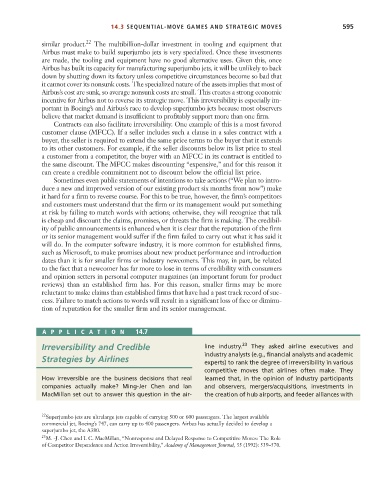Page 621 - Microeconomics, Fourth Edition
P. 621
c14gametheoryandstrategicbehavior.qxd 8/6/10 8:22 AM Page 595
14.3 SEQUENTIAL-MOVE GAMES AND STRATEGIC MOVES 595
similar product. 22 The multibillion-dollar investment in tooling and equipment that
Airbus must make to build superjumbo jets is very specialized. Once these investments
are made, the tooling and equipment have no good alternative uses. Given this, once
Airbus has built its capacity for manufacturing superjumbo jets, it will be unlikely to back
down by shutting down its factory unless competitive circumstances become so bad that
it cannot cover its nonsunk costs. The specialized nature of the assets implies that most of
Airbus’s cost are sunk, so average nonsunk costs are small. This creates a strong economic
incentive for Airbus not to reverse its strategic move. This irreversibility is especially im-
portant in Boeing’s and Airbus’s race to develop superjumbo jets because most observers
believe that market demand is insufficient to profitably support more than one firm.
Contracts can also facilitate irreversibility. One example of this is a most favored
customer clause (MFCC). If a seller includes such a clause in a sales contract with a
buyer, the seller is required to extend the same price terms to the buyer that it extends
to its other customers. For example, if the seller discounts below its list price to steal
a customer from a competitor, the buyer with an MFCC in its contract is entitled to
the same discount. The MFCC makes discounting “expensive,” and for this reason it
can create a credible commitment not to discount below the official list price.
Sometimes even public statements of intentions to take actions (“We plan to intro-
duce a new and improved version of our existing product six months from now”) make
it hard for a firm to reverse course. For this to be true, however, the firm’s competitors
and customers must understand that the firm or its management would put something
at risk by failing to match words with actions; otherwise, they will recognize that talk
is cheap and discount the claims, promises, or threats the firm is making. The credibil-
ity of public announcements is enhanced when it is clear that the reputation of the firm
or its senior management would suffer if the firm failed to carry out what it has said it
will do. In the computer software industry, it is more common for established firms,
such as Microsoft, to make promises about new product performance and introduction
dates than it is for smaller firms or industry newcomers. This may, in part, be related
to the fact that a newcomer has far more to lose in terms of credibility with consumers
and opinion setters in personal computer magazines (an important forum for product
reviews) than an established firm has. For this reason, smaller firms may be more
reluctant to make claims than established firms that have had a past track record of suc-
cess. Failure to match actions to words will result in a significant loss of face or diminu-
tion of reputation for the smaller firm and its senior management.
APPLICA TION 14.7
Irreversibility and Credible line industry. 23 They asked airline executives and
industry analysts (e.g., financial analysts and academic
Strategies by Airlines
experts) to rank the degree of irreversibility in various
competitive moves that airlines often make. They
How irreversible are the business decisions that real learned that, in the opinion of industry participants
companies actually make? Ming-Jer Chen and Ian and observers, mergers/acquisitions, investments in
MacMillan set out to answer this question in the air- the creation of hub airports, and feeder alliances with
22 Superjumbo jets are ultralarge jets capable of carrying 500 or 600 passengers. The largest available
commercial jet, Boeing’s 747, can carry up to 400 passengers. Airbus has actually decided to develop a
superjumbo jet, the A380.
23 M. -J. Chen and I. C. MacMillan, “Nonresponse and Delayed Response to Competitive Moves: The Role
of Competitor Dependence and Action Irreversibility,” Academy of Management Journal, 35 (1992): 539–570.

